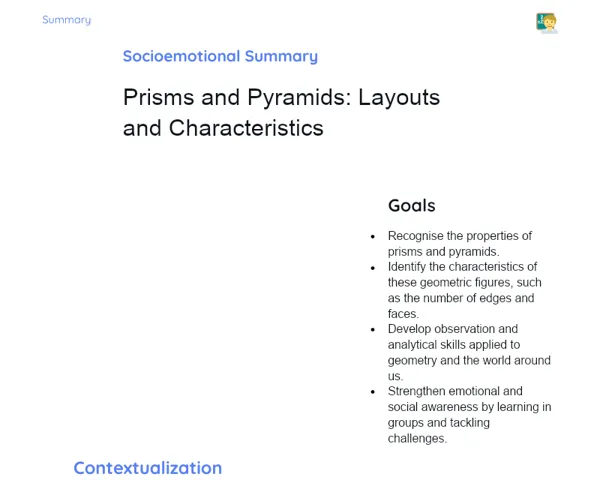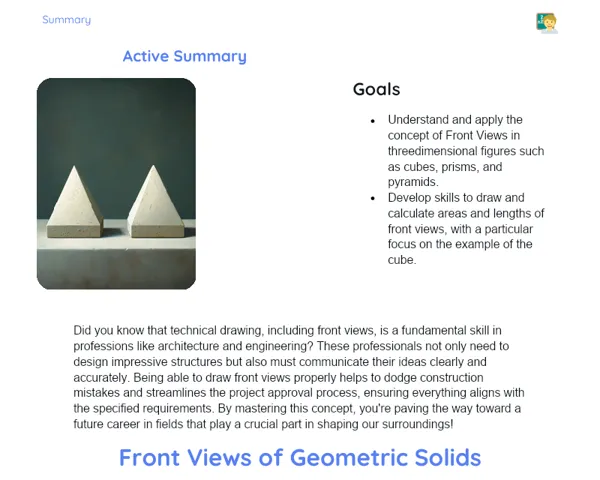Goals
1. Identify the necessary and sufficient conditions for two triangles to be similar.
2. Calculate the measures of angles and corresponding sides in two different triangles.
Contextualization
Triangles are geometric shapes that pop up in various aspects of our everyday lives, from the design of bridges to various forms of art. Understanding triangle similarity is key when tackling practical issues, like figuring out hard-to-measure distances or creating accurate scale models. This knowledge is indispensable not only in mathematics but also across a range of professions and daily tasks. For example, in construction, engineers apply similar triangles to ensure their structures are stable and secure, while architects rely on them to design scale models of buildings and bridges.
Subject Relevance
To Remember!
Necessary and Sufficient Conditions for Triangle Similarity
For two triangles to be considered similar, they must fulfill at least one of the similarity criteria. Put simply, this means that their corresponding angles need to be equal, and their corresponding sides must be in proportion.
-
Two triangles are similar if their corresponding angles are equal.
-
Two triangles are similar if their corresponding sides are proportional.
-
You can verify triangle similarity using three criteria: AA (angle-angle), LAL (side-angle-side), and LLL (side-side-side).
Triangle Similarity Criteria
There are three main criteria to check if two triangles are similar: Angle-Angle (AA), Side-Angle-Side (LAL), and Side-Side-Side (LLL). These criteria allow us to quickly determine similarity without having to measure every angle and side.
-
AA Criterion: If two angles of one triangle are equal to two angles of another triangle, the triangles are similar.
-
LAL Criterion: If two sides of one triangle are proportional to two sides of another triangle and the angles formed are equal, the triangles are similar.
-
LLL Criterion: If all three sides of one triangle are proportional to all three sides of another triangle, the triangles are similar.
Calculating Measures in Similar Triangles
Once we have established that two triangles are similar, we can use the ratio between their corresponding sides to calculate unknown measures. This is especially helpful in scenarios involving distances that are hard to access or when working with scale models.
-
Identify the corresponding sides of the similar triangles.
-
Set up the proportion between the corresponding sides.
-
Solve the proportion to find the missing measurement.
Practical Applications
-
Height Measurement: By using triangle similarity, you can measure the height of a building or tree without needing advanced equipment, just a protractor and a basic level will do.
-
Architecture: Architects use similar triangles when crafting scale models of buildings and bridges, ensuring that all proportions remain accurate.
-
Civil Engineering: Engineers rely on triangle similarity when designing structures like bridges to ensure they are both stable and safe.
Key Terms
-
Triangle Similarity: The relationship between two triangles that have equal corresponding angles and proportional sides.
-
AA Criterion: A similarity criterion where two angles of one triangle match two angles of another triangle.
-
LAL Criterion: A similarity criterion where two sides of one triangle are proportional to two sides of another triangle, with the angles formed by those sides being equal.
-
LLL Criterion: A similarity criterion where all three sides of one triangle are proportional to all three sides of another triangle.
-
Proportion: This represents a mathematical relationship between two quantities, indicating how many times one quantity can be found in another.
Questions for Reflections
-
How can we apply triangle similarity in civil engineering and architecture to ensure accuracy in construction projects?
-
In what ways do the criteria for triangle similarity help us solve problems involving hard-to-reach distances?
-
Consider a project you could create using triangle similarity. How can this concept help address practical challenges within the project?
Maker Challenge: Constructing and Using a Basic Theodolite
Create a basic theodolite and use it to measure the height of a tall object, like a tree or building.
Instructions
-
Gather the necessary materials: a protractor, straws, tape, string, and weights (like paper clips).
-
Attach a straw to the protractor's edge with tape so you can look through the straw and read the angle.
-
Secure a string at the centre of the protractor, attaching a weight at the end to serve as a plumb line.
-
Go outside and select a tall object to measure.
-
Look through the straw at the object's top and read the angle, ensuring the plumb line remains vertical.
-
Note down the measured angle and the distance from your viewpoint to the base of the object.
-
Utilise the principles of triangle similarity to calculate the height of the object you've measured.



